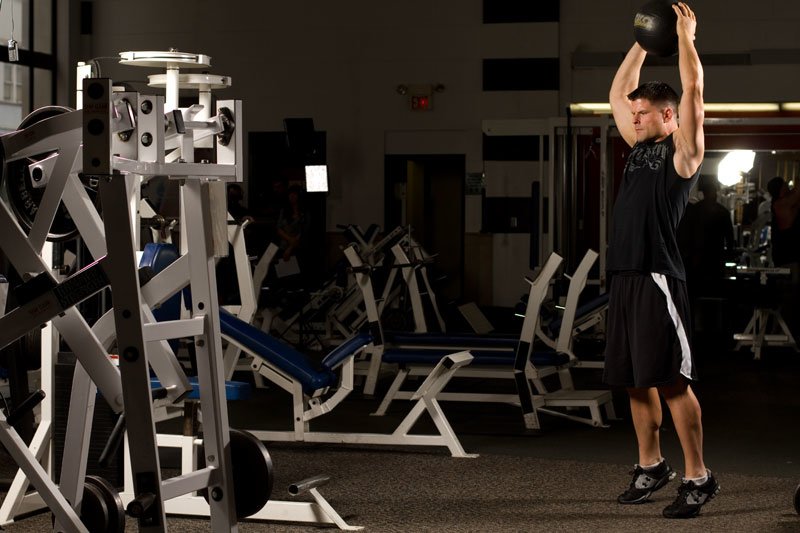I'm trying to lean out, and I'm doing a lot of metabolic circuit style training. what should I eat and drink leading up to the start of my first rep?
I'm glad to hear that you are using metabolic circuit training to lean out. This type of training gives you the greatest return on time spent in the gym, and it really cranks up your metabolism for hours after the training session ends. As for using nutrition to optimize these training sessions, specific strategies and supplements can help you maximize fat loss.
With metabolic circuit training, the goal is to do as much work as possible with as little rest as possible. So one of the main areas that we will focus our efforts on is blood flow.

Increasing blood flow to your working muscles is important because the greater the blood flow, the more oxygen, sugars, and amino acids will be delivered to your muscles to support your workouts. This helps you delay fatigue, bang out more reps, and burn more calories.
Another benefit is that the more we can increase blood flow to your muscles, the better your body will be able to clear out cellular byproducts generated from rigorous muscle contractions. Clearing out these byproducts will allow for your muscles to continue to maximally contract and perform.
Certain compounds can help in this effort:
Citrulline Malate
Citrulline Malate is an amino acid precursor to arginine. In addition to increasing plasma arginine levels and possibly nitric oxide (NO) production, supplementing with citrulline malate has been shown to increase branched-chain amino acid (BCAA) use by muscles during exercises. (You'll see how we take advantage of this when we look at BCAAs).
A 2010 study from the Journal of Strength and Conditioning Research found that supplementing with citrulline malate resulted in a decrease in muscle soreness following a chest-training session. Researchers believe that citrulline malate decreases muscle soreness through its ability to increase NO production and thus blood flow. Increasing blood flow to muscles allows your body to clear out metabolic waste generated from your metabolic circuit training faster.
This means better workouts and less soreness the next day!
BCAAs
Working muscles readily use BCAAs for fuel. As I mentioned above, Spanish researchers showed that supplementing with citrulline malate can increase BCAA usage. So we're going to provide the muscles with what they want by adding BCAAs into your workout shake.
In addition to fueling your muscles, one of the BCAAs, leucine, is the primary driver of protein synthesis. A 2002 study showed that by taking amino acids prior to weight training, you can increase muscle-protein synthesis significantly. This study also used a combination drink of BCAA and carbohydrates and found that it increased blood flow to the muscles.
That's what we want!
Dextrose/Maltodextrose Sugar Blend
Dextrose, another name for glucose, is a single sugar molecule. Maltodextrose is a strand of glucose molecules strung together. These two sugars play two key roles in your workout shake.
1
Fueling Your Muscles
Metabolic circuit training isn't conducive to burning fat as a fuel during the training session. So don't concern yourself with burning calories from fat during your metabolic circuit training session. Your goal here should be to train as hard and rigorously as you can.
These sugars are going to get to your muscles as fast as possible and feed them so that they can keep working. I recommend a blend of dextrose and maltodextrose. Research shows by combining types of sugar, we can increase the rate in which your muscles use the sugars for energy to fuel your training session.
2
Stimulating Insulin
Fast-acting sugars, like dextrose, are very potent stimulators of the hormone insulin. We want to use nutrition to stimulate insulin. Insulin will drive the amino acids and sugars into your muscles and increase their blood flow. Insulin is a powerful vasodilator, meaning that it causes your blood vessels to expand and open up.

Caffeine
Caffeine is one of the most widely used dietary supplements, serving as a pick-me-up for gym goers everywhere. While the pep is a nice bonus prior to training, it isn't the only reason I'm recommending you use caffeine in these situations.
If there's one thing that everyone dislikes about metabolic circuit training, it's that it's strenuous—your lungs are burning, your muscles are screaming, and that means you're doing it right! The good news is that caffeine can help reduce your perceived levels of fatigue during your workout, allowing you to train harder.
The Ultimate Pre-Workout Fat-Loss Shake
Here are the different dosages for each of the components that we've looked at as ingredients of your workout shake:
- 15-20 g BCAA
- 30 g dextrose/maltodextrose
- 5 g citrulline malate
- 200-300 mg caffeine (depending on body size)
- 5 g creatine monohydrate
- 33 oz (1 liter) water
Start drinking this elixir 20 minutes before your workout starts. This lag time will allow for the different compounds to reach your blood stream; when you start your first set, you'll be nutritionally locked and loaded. Continue sipping the shake for the duration of your training session. If you have any left by the end of your workout, finish it off as fast as you can.
You'll notice that I've included creatine in the shake—but I didn't talk about creatine above. Taking creatine prior to your workout isn't going to enhance that specific workout, but it is always best to take creatine with simple sugars (like dextrose), as you will get increased creatine up take by your muscles. Since you're trying to lean out, the only time that you'll be getting simple sugars should be in this workout shake. That's why I've added it here.
